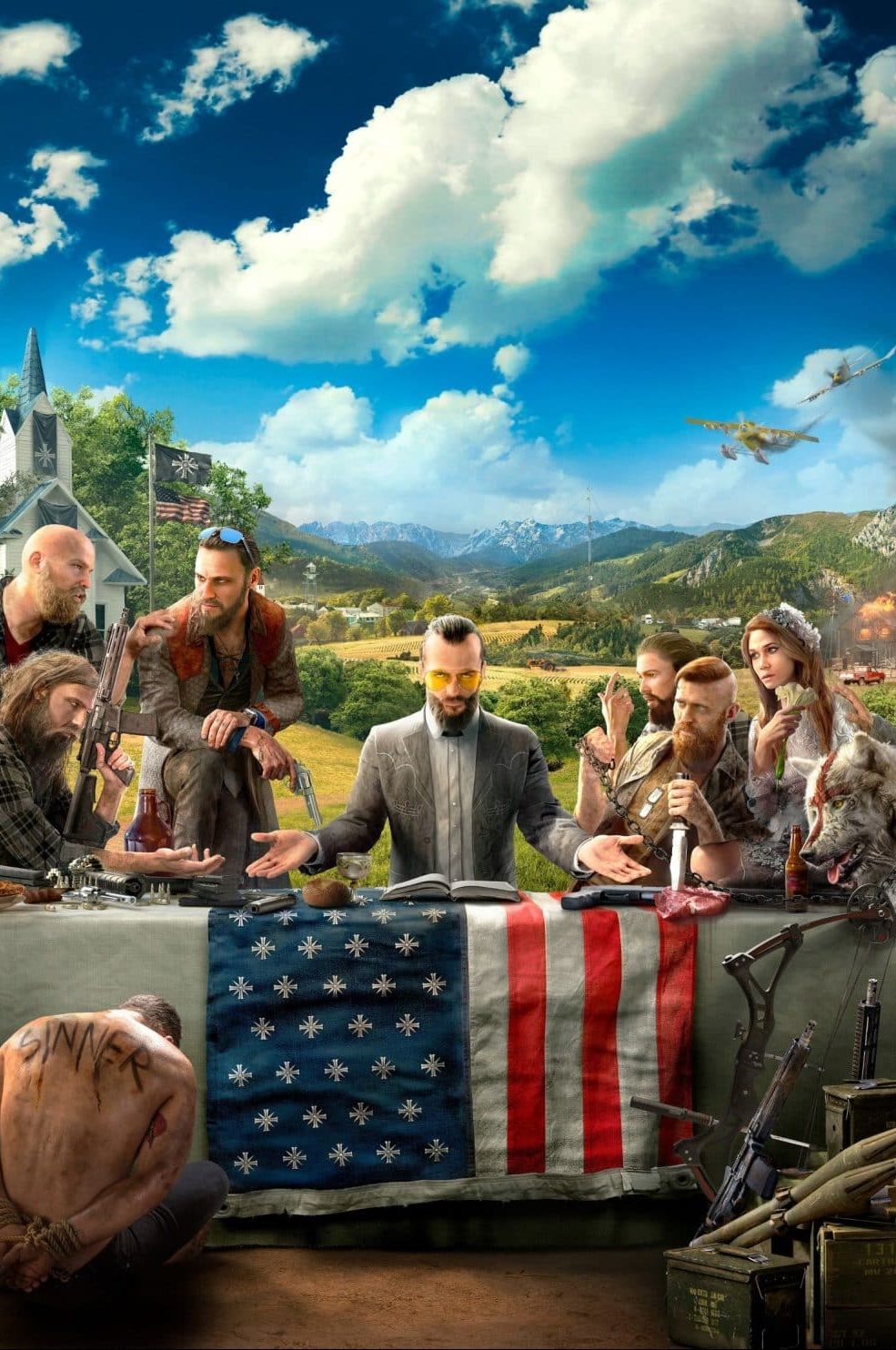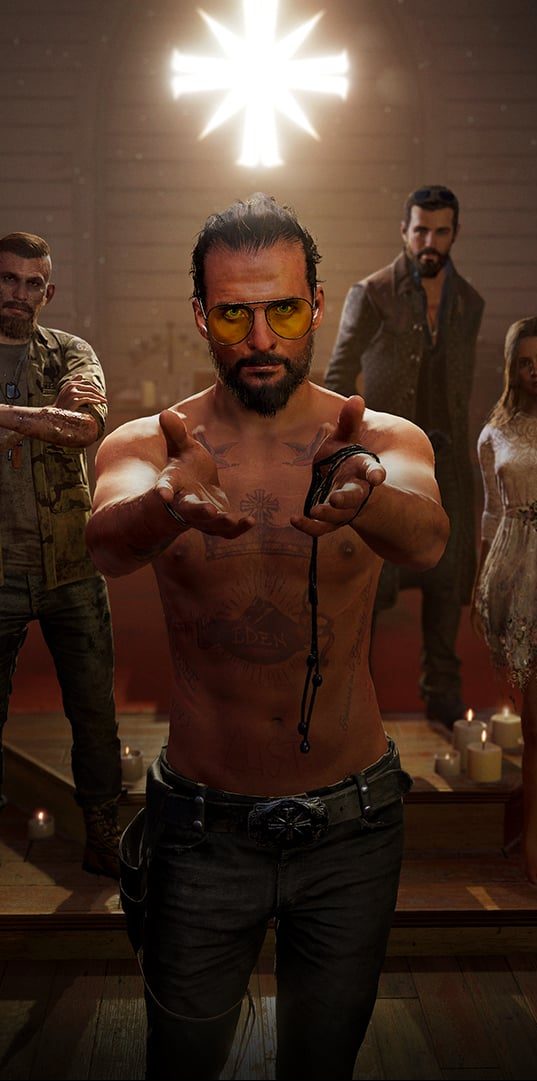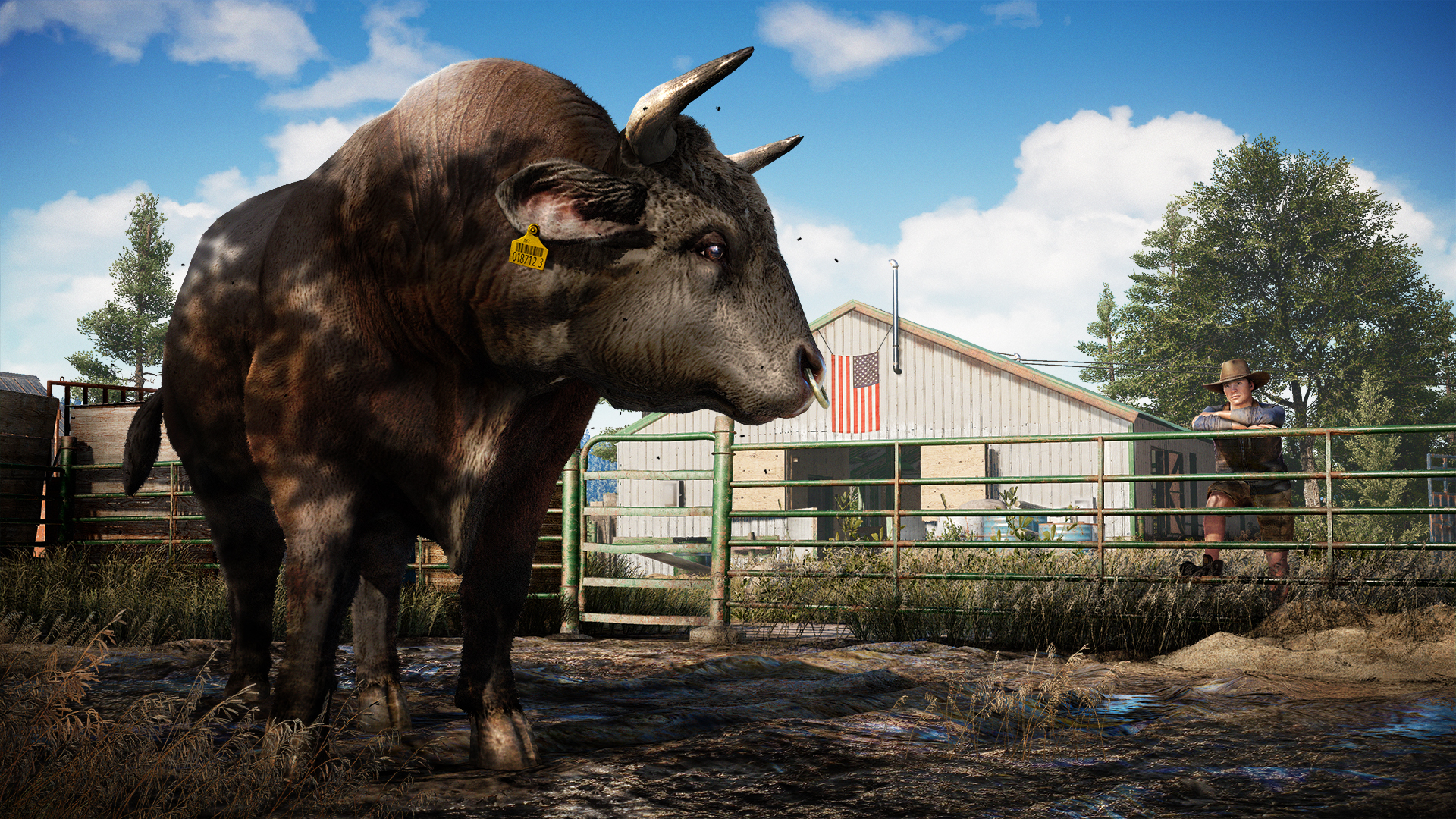
Far Cry 5 – Refusing its own politics
Far Cry 5 (Ubisoft Montreal & Ubisoft Toronto, 2018) gives the Far Cry series a well-deserved break from colonial and oriental tropes about the savage barbarians and the western savior. The game delivers a rural, right-wing power fantasy that leans into MAGA and conspiracy discourse. It is Red Dawn (1984) for the modern American culture war and paints the conservative right as the heroes and the left as the villains. The politics of Far Cry 5 are obvious, but the game refuses to reflect and comment upon the political message it sends and the political landscape it places itself into.
(Critique previously posted in Gamevironments issue no. 17 “Social justice”)
Who gets to be the hero?
The Far Cry series are action-packed, FPS adventures set in exotic locations that are fictional analogues to formerly colonized cultures. While previous entries to the Far Cry series have you take on the role of insurgents and guerrillas, fighting against an oppressive authority, in Far Cry 5 you play the opposite. You are a police deputy, an enforcer of authority, tasked with defending the local population and the status quo, rather than liberating them. The play-action is the same as in previous games, but the motivations and the message behind them are dramatically changed.
The player is supposed to take on the role of the hero, but Far Cry 5 shows that there are limits to who the series will allow to wear the mantle of ‘hero’. And that perpetuates an occidental vs colonial paradigm, of the oriental/colonial as less than the occidental/colonizing. In a western setting, being the hero means you play the part of the authorities. While in a colonial setting, the hero can never represent the authorities.
In previous games the player takes on the role of part Indiana Jones, part colonel Walter E. Kurtz, travelling up the river into the Heart of Darkness to escape the savage lands and return to civilization. The status quo of the oriental settings in the Far Cry games is always one of chaos and conflict. One which the player, as a representative of the occidental, must escape or dominate. Peace and stability can only be achieved by subjugating the local culture through violence.
Far Cry 5 shows that there are limits to who the series will allow to wear the mantle of ‘hero’
Real life fantasy
Far Cry 5 is the series’ first entry to not only be placed in an occidental setting, but also a real setting. Hope County might be fictional, but it is a believable enough representation of Montana that Southwest Montana used it in their tourism promotions (Usher 2019).
The previous games have been excused for playing to their genre conventions, but seeing the same sentiments perpetuated as we leave the fetishizing of the exotic, the problematic issue become clear. The series is created by an occidental gaze that makes use of colonial cultures as scenery and props, and not a living culture; safe from criticism through the distance of using a fictional analogue. Far Cry 5 approaches its setting in the same manner as previous games have approached their fictional settings, but there is no longer the excuse of fictionality. Through the use of a real setting, the game entrenches itself the political landscape of that setting, making the excuse impossible.

Political reality
Far Cry 5 makes heavy use of the discourse, humor, aesthetics and tropes of American right-wing conservatives, rednecks, hunters, doomsday preppers and MAGA devotees, and plays heavily into the political landscape of the United States. But refuses to comment upon or challenge the beliefs that are put into context through this use.
The game does not overtly make racist or right-wing statements, but through the use of these aesthetics, cultural identity markers, and the discourse of the groups used for inspiration, it does so by omission. This makes it stand out that much more. It is akin to building a house and forgoing to build the walls, hoping it won’t be noticed and refusing to admit there is something missing when it ultimately is.
The chatter of the locals reflects negative attitudes towards left-wing and progressive beliefs and promote propaganda and conspiracy theories. Statements like «They earned every inch of this land with blood and sweat, and now I gotta lose it to some man-buned little twerp and his posse of inbreeds?», show disdain towards cultural markers that are attributed to the American left-wing demographic, and hints at the sovereign citizen movement’s beliefs. And «Yeah, it takes a certain kind of man to defend his home», showing admiration towards a right-wing view of masculinity. “If the liberals couldn’t take my guns these Peggies sure as hell won’t!” (Peggies being in-game slang for the game’s antagonists; the Project at Eden’s Gate cult) perpetuates the American right-wing belief that liberal and democratic voices are coming for their guns. And we are directly told the enemy is “hunting people just like you” (i.e. preppers and sovereign citizens), that American liberals are after their guns and the government is lying to the population.
It is reminiscent of a MAGA or NRA rally, but Far Cry 5 fails to make any reflections or commentary towards this. And the attempted defense of this as irony, falls flat as the representation is never taken to an extreme that feels out of place with regular expectations of this demographic. Far Cry 5 also makes the MAGA devotees, the preppers and the conspiracy theorists “right”. People were coming for their guns, for their liberty and their freedom, and thus the game justifies their attitudes.
Identity markers
While the game’s villains, the Project at Eden’s Gate cult, and its leaders take their inspiration from cults such as Jonestown, Branch Davidians and the Westboro Baptist Church, they are visually inspired by fashion and cultural signifiers that are more often than not associated with an American left-wing demographic and urban youth, which forms a strange internal dissonance; they inhabit traits of both conservatives -by being a Christianity based extremist cult- and of a culture that is mostly perceived as left-leaning and progressive and often vilified by the conservative voices upon which the «good guys» in the game is based upon. It plays into the political and populist discourse established in American mass-media.
By drawing on these cultural identity markers in the design of the opposing forces, in the context of who is given the role of hero and villain, Far Cry 5 delivers a problematic political commentary. Especially considering the insurrection at Capitol Hill on June 6th 2021, the mass shooting in Buffalo, NY, on May 14th, and the numerous attacks by Qanon conspiracy believers in later years. Far Cry 5 allows right-wing attitudes to take ownership of the role of the good guy, and it is troubling to see the game failing to reflect upon the beliefs, values and political views that makes up the backdrop for the game’s events and story.
This one-sided approach also breaks with the previous entries in the series, where both sides of a conflict are criticized and shown to be morally ambiguous. In Far Cry 5 the villains are truly horrendous monsters, engaging in torture and acts straight out of snuff and horror films, but the locals are not never presented as problematic or suggested to be in the wrong. After all, you take on the role as one of them.

Far Cry 5 uncritically furthers right-wing conservative beliefs and feels like an odd mix; Parts Smokey and the Bandit, parts Ted Nugent rock show, parts Deliverance.
Far Cry 5 uncritically furthers right-wing conservative beliefs and feels like an odd mix; Parts Smokey and the Bandit (1977), parts Ted Nugent rock show, parts Deliverance (1972). The game also fails to reflect upon the colonial and racist tropes from previous entries to the series.
The rhetoric of defending liberty and the American way of life from the political left and the government, sends a dangerous message, in a game which is unsure about what it wants to be. Far Cry 5 refuses to address the use of racist and colonial tropes perpetuated in the series previous entries, but instead enforces them through the differential treatment of occidental setting and colonized setting.
The series at large does not know whether to fetishize the exotic or destroy it, and here it paints the political opposition to the message it sends as the Other. By giving the player an authoritarian role in that context and in a political landscape where that role is increasingly criticized for being a tool of conservative values, Far Cry 5 neglects to address both the legacy of the series and to reflect upon what it is and what it tells the player.

References
- Deliverance, 1972. [Film] Directed by John Boorman. USA: Warner Bros.
- Far Cry 6, 2021. [Video game] (Multiplatform) Ubisoft Toronto, Ubisoft.
- Far Cry 5, 2018. [Video game] (Multiplatform) Ubisoft Montreal & Ubisoft Toronto, Ubisoft.
- Far Cry 4, 2014 [Video game] (Multiplatform) Ubisoft Montreal, Ubisoft.
- Far Cry 3, 2012 [Video game] (Multiplatform) Ubisoft Montreal, Ubisoft.
- Far Cry 2, 2008 [Video game] (Multiplatform) Ubisoft Montreal, Ubisoft.
- Said, E., 2003. Orientalism. London, Penguin Books.
- Smokey and the Bandit, 1977. [Film] Directed by Hal Needham. USA: Universal Pictures.
- Red Dawn, 1984. [Film] Directed by John Milius. USA: MGM/UA Entertainment.
- Usher, W. 2019. Montana is Using Far Cry 5 To Promote Tourism. Cinemablend. Available at https://www.cinemablend.com/games/2465855/montana-is-using-far-cry-5-to-promote-tourism, accessed at 28 April 2022.

Subscribe to the newsletter!
Never miss an update from Critical Reflection!
Thanks for subscribing!